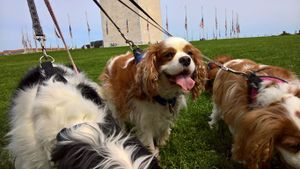Summarizing: Difference between revisions
| Line 40: | Line 40: | ||
=== Re-statement of words & sentences === | === Re-statement of words & sentences === | ||
* summarization is | * summarization requires comprehension | ||
** but it is a skill that can be taught | |||
* student comprehension is enhanced by re-stating in one's own words | |||
** it helps to discern what the student actually understands | |||
==== "Teaching it back" ==== | |||
* one method to enhance summarization and student comprehension is to engage the student in "teaching it back" to someone else | |||
** "''you can't teach it if you don't know it''" works as a good measure of student comprehension in any subject or skill | |||
** in summarization it is helpful becuase it forces the student to articulate his or her own comprehension | |||
** if the student gets stuck, the teacher can ask the student to identify Prior Knowledge: | |||
*** i.e., "Well, what do you know from this passage? | |||
*** and build up comprehension from there | |||
==== Asking questions ==== | |||
* question formulation is a process of | |||
** 1. identifying prior knowledge (what is understood or familiar) | |||
** 2. identifying new knowledge (what is not understood or familiar) | |||
** and 3. extending that prior knowledge by asking a question about it or the new knowledge | |||
==== Thinking up titles ==== | |||
* Titles are summaries | |||
** ask the student to give each passage segment a title | |||
== Lesson Plan example or student exercise == | == Lesson Plan example or student exercise == | ||
Revision as of 14:17, 12 July 2021
Summarizing is an important skill for students for
- textual comprehension
Summarizing[edit | edit source]
- the important cognitive skill of generalizing core or "Big Ideas" from larger textual or other source
- "cognition" = conscious intellectual activity, i.e., deliberate thinking
- summarizing =
- distinguishing between background and important detail
- processing in one's own words
Elements of summarizing[edit | edit source]
Active reading[edit | edit source]
- = thinking while reading =
- applying prior knowledge
- identifying new knowledge (unfamiliar words, ideas, details)
- questioning and developing questions
Simplification[edit | edit source]
- identify the core of a sentence
- SUBJECT VERB OBJECT
- see how the sentence builds up from there
- identify "emphasis shifts"
- which part of of the sentence does the writer wish to emphasize
- independent clauses = emphasis
- dependent and subordinate clauses = de-emphasis
- which part of of the sentence does the writer wish to emphasize
- getting around unfamiliar words
- strategy = replaced the unfamiliar word with "something" and read around it
- an exception can be verbs, which are important to know for sentence comprehension
- strategy = replaced the unfamiliar word with "something" and read around it
Identify background details v. Big Ideas[edit | edit source]
- which details define meaning
- v. which details add to but do not define meaning?
- ex. "Mackie is a happy little black, brown & red dog who loves to play with his toys"
- "little" and "black, brown and red" do not change the meaning that "Mackie is a happy dog who loves to play with toys"
- ex. "Mackie is a happy little black, brown & red dog who loves to play with his toys"
- v. which details add to but do not define meaning?
Re-statement of words & sentences[edit | edit source]
- summarization requires comprehension
- but it is a skill that can be taught
- student comprehension is enhanced by re-stating in one's own words
- it helps to discern what the student actually understands
"Teaching it back"[edit | edit source]
- one method to enhance summarization and student comprehension is to engage the student in "teaching it back" to someone else
- "you can't teach it if you don't know it" works as a good measure of student comprehension in any subject or skill
- in summarization it is helpful becuase it forces the student to articulate his or her own comprehension
- if the student gets stuck, the teacher can ask the student to identify Prior Knowledge:
- i.e., "Well, what do you know from this passage?
- and build up comprehension from there
Asking questions[edit | edit source]
- question formulation is a process of
- 1. identifying prior knowledge (what is understood or familiar)
- 2. identifying new knowledge (what is not understood or familiar)
- and 3. extending that prior knowledge by asking a question about it or the new knowledge
Thinking up titles[edit | edit source]
- Titles are summaries
- ask the student to give each passage segment a title
Lesson Plan example or student exercise[edit | edit source]
Example 1: discerning background details from Big Ideas[edit | edit source]

1. Details:
- black, white and red-haired, small dog
- big green toy
- green carpet
- flooring showing in upper right corner
- foot of a table showing to upper left
2. Unimportant details: 3. Important details
- dog
- toy
4. Other ideas to infer:
- dog posed quietly for the photo
- dog seems to have already played with the toy
- the toy does not appear to have rips from chewing
5. Big idea:
- what do we learn about the dog?
- he likes the toy or toys
- therefore, It is a playful dog = the BIG IDEA
- what do we learn about the dog?
Example 2: discerning background details from Big Ideas[edit | edit source]

1. Details:
- three dogs, one multi-colored, two white-brown
- dogs on the grass, one sniffing the ground
- Washington Monument in the near background
- some other buildings in the further background
- flags
- we might also notice that the flags are at half-staff
2. Unimportant details:
- far background buildings
- grass (fields have grass, so we learn nothing from that)
- presence of flags at Washington Monument
3. Important details
- three dogs
- the Washington Monument
4. Other ideas to infer:
- the photographer, perhaps owner, deliberately posed the dogs in front of the Washington Monument
- perhaps the photographer/owner could not get the dogs to pose and all three look at the camera
- the flags at half-staff could be significant
5. Big idea:
- what do we learn from the photo?
- the dogs are alert, not fighting
- the choice of the Washington Monument in the background is purposeful
- therefore, Three dogs enjoying a walk by the Washington Monument = the BIG IDEA
- what do we learn from the photo?